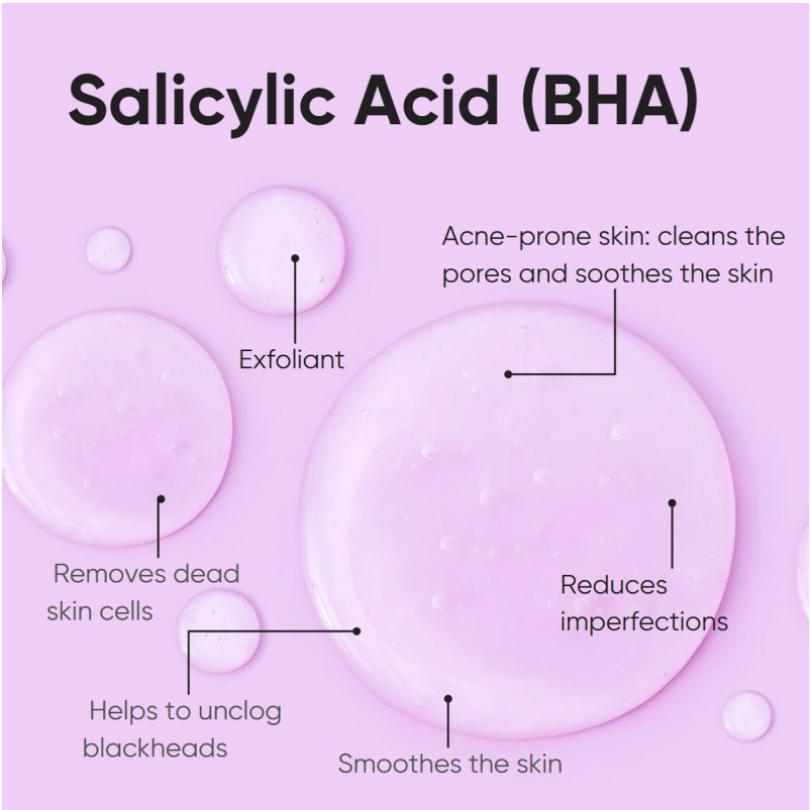✨Welcome, skincare enthusiasts! ✨
Today, we’re diving into the world of Salicylic Acid, specifically at the 2% concentration. If you’ve been curious about this beta-hydroxy acid (BHA) and its incredible pore-clearing abilities, you’re in the right place. Let’s break it down into easy-to-digest insights so you can make the most out of this skincare hero!
🌟 What is Salicylic Acid?
Salicylic Acid beta-hydroxy acidis a (BHA) that’s famous for its ability to clear pores and improve skin texture. Here’s what you need to know:
- Derived from willow bark, it’s a natural exfoliant.
- Unlike AHAs (alpha-hydroxy acids), it’s oil-soluble, meaning it can penetrate deep into pores.
- It’s closely related to aspirin and shares some of its anti-inflammatory properties.
- Perfect for tackling acne, blackheads, and oily skin.
🔬 The Science Behind Salicylic Acid 2%
1. Pore Penetration
- Thanks to its oil-solubility, Salicylic Acid can cut through sebum and penetrate deep into pores.
- This makes it highly effective for treating acne and blackheads.
2. Exfoliation Mechanism
- Loosens the ‘glue’ between skin cells, promoting gentle exfoliation.
- Clears out clogged pores and smooths skin texture.
3. Sebum Regulation
- Helps normalize sebum production, making it a great choice for oily skin types.
4. Anti-Inflammatory Effects
- Naturally reduces redness and swelling associated with acne.
- Soothes irritated skin, leaving it calmer and clearer.
5. Keratolytic Properties
- Softens and dissolves keratin, a protein that can block pores.
- Enhances the removal of dead skin cells, revealing smoother skin.
🤔 Why 2% Concentration?
- 2% is the gold standard for over-the-counter Salicylic Acid products.
- It’s potent enough to deliver results without causing excessive irritation for most skin types.
- Higher concentrations are typically reserved for professional treatments.
🛠️ How to Incorporate Salicylic Acid 2% Into Your Routine
- Start Slowly:
- Begin with 2-3 applications per week, increasing frequency as your skin adjusts.
- Application:
- Apply to clean, dry skin before moisturizer.
- Use as a spot treatment or all over the face, depending on your needs.
- Timing:
- Best used in the evening due to its exfoliating properties.
⚠️ Things to Keep in Mind
- Dryness or Irritation: Salicylic Acid can cause mild irritation, especially when starting out.
- Sunscreen is a Must: It increases skin sensitivity to UV rays, so don’t skip SPF during the day!
- Not for Everyone:
- Avoid if you have very dry or sensitive skin unless advised by a professional.
- Pregnant or nursing? Consult your doctor first.
- Hydration is Key: Pair with hydrating ingredients like hyaluronic acid to maintain skin balance.
🧪 Salicylic Acid and Other Ingredients
- Works Well With:
- Hydrating heroes like niacinamide and hyaluronic acid.
- Use With Caution:
- Avoid combining with other exfoliating agents like AHAs or retinoids in the same routine to prevent over-exfoliation.
- Steer clear of other salicylate-containing products to avoid over-exposure.
🛠️ Benefits for Different Skin Concerns
- Acne: Unclogs pores, reduces inflammation, and prevents future breakouts.
- Blackheads & Whiteheads: Dissolves debris within pores for clearer skin.
- Oily Skin: Regulates sebum production for a more balanced complexion.
- Rough Texture: Exfoliates to smooth and refine skin over time.
- Mild Hyperpigmentation: Promotes cell turnover to fade dark spots gradually.
⚖️ Salicylic Acid vs. Other Exfoliants
- AHAs: Work on the skin’s surface to target fine lines and uneven texture.
- Salicylic Acid: Penetrates inside the pores, making it ideal for acne and oil control.
- Gentler than AHAs: Often better tolerated by sensitive, acne-prone skin.
⏳ Consistency is Key
While some may see quick improvements, it typically takes 4-6 weeks of regular use to notice significant changes in skin clarity and texture. Stick with it, and your skin will thank you!

